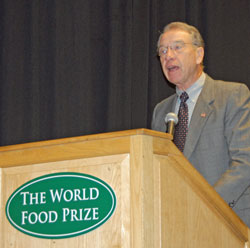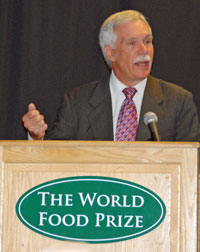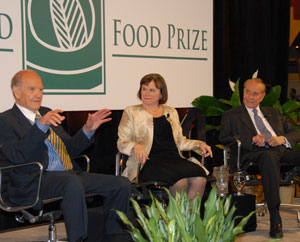Republican Senator Chuck Grassley of Iowa paid a visit to the World Food Prize breakfast on Friday morning to introduce the secretary of agriculture and make a few comments of his own about the importance of American agriculture in feeding the world, as well as honor his colleagues from the Senate, George McGovern and Bob Dole, who are this year’s World Food Prize recipients.
 He believes that increasing the use and acceptance of biotech crops is vital. “We’re entering a new generation in agriculture,” Grassley said. “This generation not only encompasses feeding the world, but also fueling vehicles and eventually getting in to treating patients through pharmaceuticals in crops. This offers opportunities for biotechnology growth throughout the world that will continue to feed populations and provide new prospects for our rural communities.”
He believes that increasing the use and acceptance of biotech crops is vital. “We’re entering a new generation in agriculture,” Grassley said. “This generation not only encompasses feeding the world, but also fueling vehicles and eventually getting in to treating patients through pharmaceuticals in crops. This offers opportunities for biotechnology growth throughout the world that will continue to feed populations and provide new prospects for our rural communities.”
In a brief interview after the breakfast, Sen. Grassley said that biotechnology gives us an opportunity to have a stronger agriculture allowing for multiple uses of agricultural crops. “Things like the World Food Prize give an opportunity to educate people about biotechnology,” Grassley said. “By expanding agriculture you can provide food, fiber and fuel.”
Grassley said that the incentives for biodiesel included in the financial bailout passed by Congress are critical to development of the industry. “That’s how you get infant industries started,” he said. “The best proof of that is that we would not have an ethanol industry today were it not for the ethanol incentives.”
He got very passionate about the need for incentives in developing any alternative energy. He used the example of developing cellulosic ethanol. “People say we ought to have cellulosic so we’re not using grain, but how do they think we’d ever get a second generation of ethanol from cellulosic if we don’t have the first generation of ethanol, and we wouldn’t have the first generation if we didn’t have the tax incentives and the public policies to encourage an infant industry.”
Asked if he is concerned about Senator McCain’s comments about doing away with ethanol incentives, Grassley said, “Not as long as I’m in Congress. When he’s president of the United States, we’ll still be developing an ethanol industry.”
Listen to an interview with Grassley at the World Food Prize here:
[audio:http://www.zimmcomm.biz/world-food/wfp-08-grassley.mp3]
You can also download the audio with this link:
Chuck Grassley interview (mp3)


 The answer to feeding a growing world population lies with building on the success of the American farmer, according to Agriculture Secretary Ed Schafer, who addressed the World Food Prize breakfast Friday morning in Des Moines.
The answer to feeding a growing world population lies with building on the success of the American farmer, according to Agriculture Secretary Ed Schafer, who addressed the World Food Prize breakfast Friday morning in Des Moines. The
The  As promised, I’ve got some more material for you from Secretary of Agriculture Ed Schafer, who addressed attendees of the Farm Foundation’s Transition to a Bioeconomy: Environmental and Rural Impacts Conference in St. Louis, Mo.
As promised, I’ve got some more material for you from Secretary of Agriculture Ed Schafer, who addressed attendees of the Farm Foundation’s Transition to a Bioeconomy: Environmental and Rural Impacts Conference in St. Louis, Mo. The president of the World Bank made an appearance at the
The president of the World Bank made an appearance at the  The ability of the world to grow enough agricultural crops to produce both food and fuel was a topic of discussion at the World Food Prize symposium in Des Moines on Thursday, which was also World Food Day.
The ability of the world to grow enough agricultural crops to produce both food and fuel was a topic of discussion at the World Food Prize symposium in Des Moines on Thursday, which was also World Food Day. Making soybeans into biodiesel is no food versus fuel competition – rather it is food AND fuel.
Making soybeans into biodiesel is no food versus fuel competition – rather it is food AND fuel.



 The recent credit crisis in the country was certainly a hot topic of conversation at today’s Farm Foundation Transition to a Bioeconomy: Environmental and Rural Development Impacts Conference here in St. Louis, Mo.
The recent credit crisis in the country was certainly a hot topic of conversation at today’s Farm Foundation Transition to a Bioeconomy: Environmental and Rural Development Impacts Conference here in St. Louis, Mo. U.S. Secretary of Agriculture Ed Schafer has just finished addressing the folks attending the latest Farm Foundation’s Transition to a Bioeconomy Conference going on in St. Louis, Mo.
U.S. Secretary of Agriculture Ed Schafer has just finished addressing the folks attending the latest Farm Foundation’s Transition to a Bioeconomy Conference going on in St. Louis, Mo.